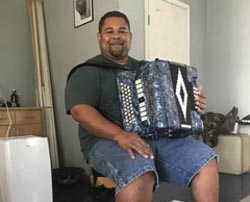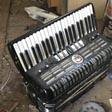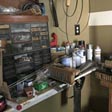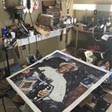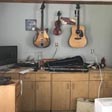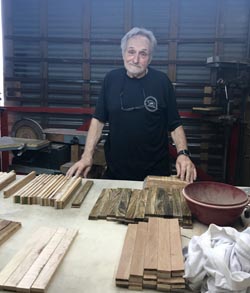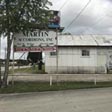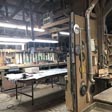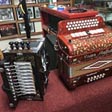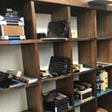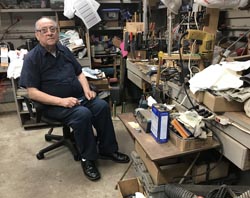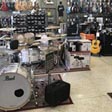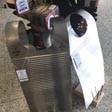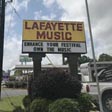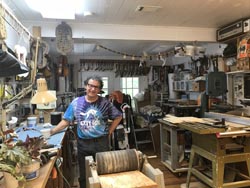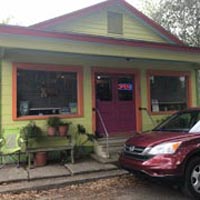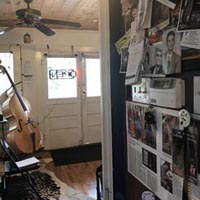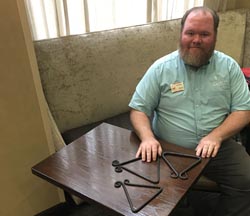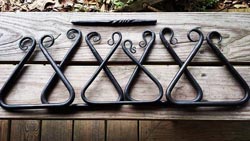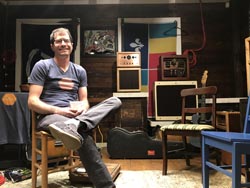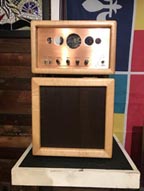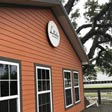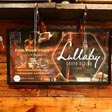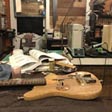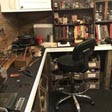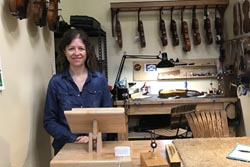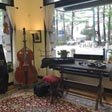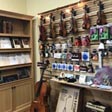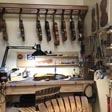Innovation, Tradition, and Change in Louisiana Musical Instrument Making and Repair
By Holly Hobbs

Dexter Ardoin, Accordion building/repair
Creole accordion player and multi-instrumentalist Dexter Ardoin lives in Scott, Louisiana and is a member of the legendary Ardoin family (his grandfather is Bois Sec and his father is Morris Ardoin). Dexter is an accordion builder and repairer as well as a Zydeco/Creole/Cajun performer, but in recent years music has taken a backseat to work and family. He talks of his life and music.
Dexter Ardoin grew up near Eunice, Louisiana. His father, Morris, was a multi-instrumentalist, just like so many others in his family, and Dexter remembers his father's favorite song being "Eunice Two-Step." He began on the accordion at age 3—originally, his father didn't want him to play it, since it was such an expensive instrument, but Dexter persisted, and his first public performance was at age 4 at a local jam session. He joined his grandfather on stage at age 6 and went on to play drums in his grandfather's band. The first song he loved to perform was "Zydeco Cha-Cha," but his family didn't want him to play Zydeco at the time because the performance aesthetics of Zydeco were too hard on the instrument (they preferred the traditional Creole ballads of the era).
Dexter had always worked with his hands, and the first part of his career outside of music was spent doing construction. Throughout changes in career, Dexter continued to perform. He speaks more on his journey to accordion repair:
In 2001, 2002, I had broken a reed in my accordion. And I was going to leave to go on tour, I was gone for two weeks. Nobody could fix it for me, no one had time to fix it. So I called Larry Miller . . . and he was like, "Well, I can't fix it for you right now because I'm not home, but if you come by the house I can leave the reed for you and you can fix it yourself." So I was like okay, that sounds good, it can't be that hard, it's already broke so can't mess it up no more. Went to Larry's house, got the reed, came back, I opened that accordion up, I said "Wooo, which one?" So it took a little time to figure it out, but then I started figuring it out, and something like, "You know what? I think I could fix my own stuff when it breaks."
Kept doing it, every time it'd break I'd fix my own. Next thing I know, some friend, "Hey man, I'm in a jam, nobody can fix my accordion." "Ah, bring it by the house, let me see what I can do." So they would come, I'd fix them up, kept going, kept going, still to this day I still do that. Had friends that, when they in a jam. And it just kept going, kept going, kept going. And one day I called Larry, we was talking, I say, "Larry, I want to build an accordion." He said "Oh no, man, you can't do that," this and that, this and that. So it went on for about two or three years.
So then one day, we're talking on the phone, and I ask him again and say, "Larry, I want to build one. I'm serious." And he say, "Well, come by and meet me tomorrow. So I went by the next day, worked with him all day, we cut parts" . . . and he say, "You think you can do it?" And I say, "I know I can." And we kept talking, kept talking, he said, "Come back tomorrow." So I went back the next day, all the parts were cut, that's what we needed for the next day. So we start putting them together and I say, "I think I can do this." Build one with him, no actually, he gave me all the parts, so I came home, starting putting everything, man, this and that. . . . I had a bunch of carpenter tools, but it wasn't the ones that I needed for accordions. . . . Six months later, I got an accordion.
I went by Larry Miller, I say "look, man!" He say, "no, no, no, no. Come back tomorrow and we're gonna do it together. And I'm looking at mine and say, "Man, this took me 6 months to do this. What's wrong with it?" And he say, "Put that on your shelf and leave it up there." So when I came back the next day . . . and he starts showing me about all the stuff I had done wrong.
From there, Dexter built 5 more accordions, which Larry Miller finally approved of. Since that time, he's gotten many requests, but doesn't have the time to dedicate himself fully to it, although he plans to return to building soon. To him, however, it is his father's accordion that is still the most beautiful.
That one, I love the sound of that one. I cannot get another accordion to sound like that. . . . Dealing with reeds, the older they are, the better they sound. Might sound crazy. But some accordions, you can have a brand-new accordion, some might sound good. If it sounds good now, it's gonna sound even better when it gets older. Because as everything matures together, it just makes a better sound. It just has a distinct sound that you can't explain.
His next job, he says, is to teach his children to play and build accordions. Carrying on the family tradition is at the heart of all Dexter Ardoin does.

Junior Martin, Accordion building/repair/shop owner
Francophone Cajun accordion builder and repairer, Junior Martin, maintains his accordion shop/workshop, Martin Accordions, outside Lafayette in Scott, Louisiana (located at 2143 W. Willow Street). His son also works at the shop along with his daughter, Pennye. She runs all the administrative duties involved with Martin Accordions, along with their Internet presence, intake of accordions, sales, scheduling tour groups to come tour the workshop (they also hold short performances on their small stage for tours), as well as building and repair work.
Junior Martin was born in Cankton, Louisiana, 15 miles north of Scott, where he currently lives and works. His grandfather was from France, and his was a French-speaking and farming community, with Mr. Martin growing up picking cotton alongside a large family full of musicians. He began a career in carpentry as a young adult and started a family. He had always wanted an accordion but was told that accordion music was dying and that it had no future, so he bought a lap steel guitar instead, learning country and western in Nashville and touring with a long list of popular country and western and Cajun bands.
Junior Martin had toured with Marc Savoy as well over the years, and spent time watching Marc make accordions. Marc told him to go home and take apart his own accordion and study it, as well as giving him printed documents to study. "You can't build one accordion," Marc told him, "it's too much trouble. You gotta build a bunch." In the next few years, Mr. Martin built 52 accordions.
Junior Martin opened his music shop, Martin Accordions, in the mid-1970s. It had always been his carpentry shop, but over the years turned into exclusively an accordion building and repair warehouse. Today, they supply accordions to buyers all over the world, with Pennye managing their website and online sales. His children are all his apprentices, he says, along with one other maker, Lee, that he formally apprenticed. The starting price for a Junior Martin accordion is around $2,600 and goes up from there, depending upon the level of decoration and custom creation. Junior Martin discusses more of his building styles and aesthetics:
We use a number of different woods, probably about 40 different woods. About 10, 12 different rosewoods. And some woods we can't get anymore because now you can't get it. But most of it you can get, . . . so we use a lot of maples. . . . Well, everybody tells me [mine] are the best accordions. Even other accordion makers tell me that, "You have the best accordions."
In these cubbyholes, they're ready to assemble. So when a customer walks in and says they want this one, we can do it in three days, now we don't try to do that all the time because we're so busy. . . . Everything [over there] is sold, that's a lot right there, 8 or 9, you said? [Talks to Pennye]. Everything over there is repair work. We repair any kind of accordion, piano accordions, all the old stuff.
He continues about how his business became successful:
It just got started so good for us on accordion. I had all these accordions together ready to start as soon as I could get reeds, I had one put together, I didn't know how good it would sound, even. I had thirteen sold. And so that really gave me the incentive to go out big time and start getting them more and more ready.
He talks at length about his apprentice and his children, and how his apprentice assisted in his work and how they were able to grow the business even larger. When asked about his favorite parts of the accordion building process, responds:
Probably cutting all the wood, what I'm doing right now. I love doing that. I just love to work with wood. . . . I don't like to make cases that much but I've gotten to like it since I started making a lot of them now . . . when I first started making my own cases about 7 years ago—old man that did it for us died and I couldn't find nobody else—so we bought enough wood to make 100 cases.
And so my son, he cut all that wood up and when he ran out, I had to go to do the same thing, but at that time he was doing construction. But he used to have, like, 10, 12 cases, maybe 20 cases sometime. And he didn't have something else to do, I let him make cases. But now we're only two so Pennye needs me in here for fingerboards, that's one thing she hasn't started doing yet, I'm sure she will when the time come but Lee [his apprentice] can do it, Lee's good enough to do it.
Junior Martin's most well-known accordion decoration is the crawfish design on the bellow. Pennye gets the accordions ready for him, he says, and then he does his designs in the lacquer room, and his son assists him with the etching of the glass. He talks of online sales versus the store:
A lot of it is local. People find it easier to email you to see what you got available and all that. But probably half the accordions we sell is in Louisiana. The other half is the rest of the state and the world. It's a lot overseas, we sell to all different countries out there, you can't imagine. There's some countries, you take Norway, they have about 80 Cajun bands out there and there's only one accordion maker.
So a lot of people, they come over here and visit, they stay with us out here, we play music together and some of those guys play Cajun music just like us. I haven't met any steel guitar players, but good guitar players and good accordion players and of course they always want to play with my grandchild, my grandchild already went out there, spent two weeks out there, Norway and Denmark and different countries, maybe Holland.
Pennye discusses walk-ins to the Martin Accordions store:
When you're talking about a handmade instrument, like you said, they're pretty much customized for the customer, people want to handpick it. You know, they want to see it. So you can come in and see all the different wood types and colors we have. They like to visualize it but when they see it, it makes it more oriented toward each individual customer, and that's what people like. When people shop for cars, they want to drive it and see it, not just see a picture of it. [A producer in Nashville] drove here to handpick the accordion that he wanted. So a lot of people will do that. But if that's not feasible to do, we'll talk them through it over the phone.
Pennye talks about the tours that she hosts, saying that last year they had about 150 tour buses that came to tour Martin Accordions and hear a performance on their small stage. "It's a chance for us to give back and share our culture. Because many of them have never even heard Cajun music or Creole or Zydeco, and they don't know the difference. So it gives us a chance to share, you know, the music, not just the instrument. We introduce the music, we talk about the history of the music, which is just as important as the music itself."

Max Theriot, Brass/woodwind repair/shop manager
Brass/woodwind repairer Max Theriot has worked for decades at Lafayette Music Company, located at 3700 Johnston Street in Lafayette. Lafayette Music Company is one of the largest music stores still in operation in the area, and carries a wide array of inventory, including many types of instruments, including pianos, rubboards and Cajun-specific instruments, along with sheet music, lighting equipment, etc. Much of the business they do is providing instrument and costume rentals to the high school brass bands in the area. Lafayette Music Company has a full repair shop with three full-time workers. Mr. Theriot talks about repairing over time and the changing role of the music store.
Max Theriot was born in St. Martinville, Louisina. Many of his family members worked offshore, and he grew up drawn to music. By high school, he was a saxophonist and played in the school band, followed by performing in rhythm and blues groups playing The Platters, Fats Domino, and other standards of the era. He had a passion for and love of saxophone from an early age, which is what went on to influence his life's work. After school, he began working at Woolworth's, followed by a job at Romero's music store as an instrument repairman. He was largely self-taught, both educating himself through trial and error and with the help of a brass and woodwind instrument repair manual. He is a methodical and careful repairer, aiming for technical precision to create the sound he desires, rather than artistic flair. At one time, he started his own repair business, building a small shop in his mother's yard and doing repairs out of that location. That didn't last long, since it was hard to attract enough clients on his own to make it financially viable, so he returned to Romero's. He traveled to Michigan to complete a formal course in brass/woodwind repair, and when he returned home he bought $2,000 worth of repair equipment. He still operates a small workshop out of his house, but the majority of repairs he's done over the years has been through Lafayette Music Company, where he eventually came to work decades ago.
When asked why Lafayette Music Company has stayed in business where so many other music stores have failed, he responds that it is because of the quality of their customer service. He says they also have straightforward pricing that competes with the Internet, and the amount of high school bands needing instruments in the area keeps them busy.
His favorite instrument to repair is the clarinet—he enjoys the instrument and the process. He speaks here on the changes he's seen over time with the major brands of brass and woodwinds:
Elkhart, [Indiana] used to be the center of the band instrument capital of the world, but that all changed when Kahn moved out. . . . Olds isn't in business anymore, you can still buy an Olds but it's made in Taiwan. . . . What happened with the band instrument business is the same thing that happened with the brass manufacturing business and the bathroom fixtures and faucets and all that.
When I was in high school, Selma was a brand to contend with. And now, Selma is still a great brand but Yamaha seems to be the largest in the world. But Yamaha is doing the same thing as the other companies. At one time, everything from Yamaha was manufactured in Japan. Now they manufacture the top of the line, all the flutes, all of that is produced in Japan. But the student line, in fact I'm working on a flute right now that's a Yamaha, but in fact it's made in Indonesia. Or it's assembled or fabricated [there], . . . so even the Japanese are looking for cheap labor. . . . What's going to happen in the future? The band instrument industry is all going to be in that part of the world.
He talks of how realities have changed for musicians on the ground locally.
I deal mainly with flute, saxophone, and some clarinet. I'm strictly woodwind now, I do them all, but because of my health and because over the years I've trained several people, so I don't have to do the brass, because woodwinds take a lot more time than brass to do. So what happened is these musicians that were strictly Selma, or King players, or Kahn players, they have to be convinced that Yamaha is a better product. . . . The musician really has to decide whether he likes this instrument better than the old Selma.
When I was playing music, I bought a [Selma tenor sax] from a musician who paid $800 for his brand new, . . . so he sold it to me for $500. That same saxophone [today] in lacquer is about 5 or 6 thousand. In silver, you can add another couple thousand. . . . The Yamahas might be a thousand dollars cheaper than the Selmas.
In terms of plating, he continues:
Now today, some of these manufactures are making trumpets and so forth without a finish. They want that raw brass. But it's a big mistake, because you're spending all your time cleaning and really you can't reach in every spot, so what happens is that accelerates the loss of the brass. The brass will corrode and once it corrodes there's nothing you can do about it. It will develop red pit marks, which is called de-zincification. The body acids leach out the zinc, which is part of the alloy. Because your brass instruments really aren't just brass. We call it brass as an alloy of zinc and copper, like 60/40 and so forth. And bronze has more tin in it. Saxophones have a different alloy.
Now, Selma had a different alloy in their top of the line horns. Yamaha has a different alloy in their student line, we sell gobs of them, especially saxophones, trumpets and so forth. But they don't use the same grade of brass that they do in the top of the line. But Yamaha does so much research in acoustics and so forth, it's really hard to compete with them.
"So the repair business has changed," he concludes, "and I'm fortunate that I stuck with it. And Lafayette [Music Company] seems to be the center around here." When asked what he likes best about his life's work, he responds:
It's hard to put into words. I like working with my hands. I like to repair. I like the sound that the instrument makes when you blow it. And I squeak on the flute and clarinet, but I have methods to tell whether the instrument is leaking or not. I'm very slow and careful, so that I try not to miss anything. And whenever they have a problem, they come to me. . . . I still have a few tricks that they haven't learned yet. And I'm taking them with me [laughs].

Tom Pierce, Violin building/repair/shop owner
Tom Pierce's violin shop and workshop is called Tom's Fiddle and Bow, located at 204 Fusilier Street in Arnaudville, Louisiana. The store's front room is a jam session space, along with rows of handmade violins for sale that Tom has either built or repaired/restored. Behind that is a kitchen and an office and a separate entryway that leads to his private workshop where he makes fiddles and other wooden objects. Arnaudville has of late become something of a cultural center due to the success of the neo-traditional Cajun roots band Lost Bayou Ramblers, who live down the road from Tom's fiddle shop. Anya Burgess, another fiddle maker, also lives in Arnaudville. Tom discusses the ups and downs of his business and the difficulties and successes he's experienced over time.
Tom Pierce grew up in Massachusetts and found a love of bluegrass music early on. He worked in a shipyard for decades, for which he received a pension in his early retirement that allows him to focus on his fiddle work full-time. While working in the shipyard, he began going to bluegrass festivals and learned to play the fiddle. He first learned violin repair from the Violin Repair Institute in New Hampshire, which was followed by an interest in Cajun music in the 1990s. It was his attendance of Cajun festivals that began his path to Louisiana, while he focused more on violin building and took classes in varnishing. He and his wife moved to Lafayette in 2005 and soon relocated to Arnaudville, where he founded his violin shop on the main street there. His violin building style is slow, careful, and ornate.
Business was steady from the beginning, he says, primarily due to the jam sessions, which were supported early on with an arts grant. He continues:
I would have six leaders lead six jams, one every other month. I wanted 12, but they only gave me half the funds. So I went with six. I would pay the musicians to come and lead the jam. Whoever played, I'd pay. I got two people [each], so I paid them $200 for two hours. . . . So that was a big success, so that got me on the map. We put that gate up and we'd leave the door open if it's in the summer, and in the winter it's closed. But anyone can come in, I put emails out, you know, now I know how to do events a little better so I do events now. So we were doing it every week for six years. And my wife would cook and it would be great.
When asked about his favorite parts of the building process, he responds:
I'm pretty good at set-up, so I think that's my specialty. And I can do pickups and fingerboards, I can do everything. Well, I haven't reset a lot of necks, because [my teacher] never taught me. But I'm learning how to do that. But the more you build, you'll get better at that.
His business is still word of mouth and walk-ins, although he has started advertising via social media, along with an email list he uses to keep his customers apprised of his work and the schedule of the jam sessions. Tom also holds violin lessons at the shop, which helps his business. So much of it, he says, is simply maintaining people in and out of the store. He elaborates about what he loves about owning a music store:
I can set my own hours. I love the weather. I have this whole space, I can do anything I want all day long, it's just lovely. And I finally get to use that business degree that I got back in 1980, so I finally get to use it. And I'm so grateful because I put six and half years of my life into that. And I just like ownership. I'm in charge of my own destiny. I guess another thing, something that you said, it feels really comfortable in here. And that's what I try to do.

Jay Steiner, Musical triangle (t-fer) building/repair
Lafayette-based artist, Jay Steiner makes traditional Cajun triangles, or t-fers, in addition to doing other blacksmithing. He discusses his making of triangles as well as his deep love of Louisiana history.
Jay Steiner was born in Georgia and grew up in Lafayette. He graduated from the University of Louisiana with a degree in history, and soon became a high school history teacher, along with a job as a historical tour guide at Vermillionville Living History and Folk Life Park, which was built to protect the Vermillion bayou and watershed, as a tour guide. They didn't have a blacksmith working in the park at that time, and he decided to try to learn how. Much of what he has done has been self-taught or learning through books, influenced by his deep love of history and old ways of doing things. He has always been attracted to making historical pieces that are usable in everyday life, and at that time he was searching for an instrument that he could play. He soon settled on the triangle and began using his blacksmithing skills to create them. He elaborates:
When I first started making the triangles, I just found a little bit of old scrap metal and started making them that way. I talked to a lot of musicians around here and looking at some of the photographs—we have a big wall full of old pictures of triangles [at the park]—and talking to people who play them in bands. . . . and then kind of doing my own thing with it. I've always had a bad habit of not following a recipe, if I'm trying to cook I'll try to put own spin on it, that's what I try to do with the triangles.
Whereas many who make them try to make them uniform so they all look the same so you have consistency to your product, every single one of mine looks different and they don't look like each other, but I can tell they're mine when I see them. . . . I started to do more decoration on kind of the finials at the top. . . . Most people would try to keep them simple, I decided, that's one area I could add a little something to it and it wouldn't affect the sound, or if it did affect the sound it just makes it different in a good way. And I started using different materials to do it, I eventually settled on some cold rolled steel, which has a nice ring to it, if you muffle it properly you can still get that old clang that you get from the old hay rake tines that they used to use, but they're not going to break on you. That metal is 70, 80 years old and has been sitting out in a field and rusting for years. You could throw it off a building and it'll still be here in 200 years, after we're all gone. Probably longer.
So getting to put my own spin on it, that's about half of the art of enjoying doing it. I like, you know, focusing on the past, keeping tradition alive, but also updating, changing it. Making it kind of my own thing. I like to stand out from others but also stand alongside all these others who are keeping the music and the craftsmanship alive.
"Anyone can play the triangle," he continues, "that's the wonderful part of the instrument, is that, opposed to the accordion or fiddle, as long as you're not afraid of embarrassing yourself when you get that first note wrong and everyone can hear you, if you can get past that—and there's a metaphor in there somewhere—if you can get passed that first mistake, you'll be good, and people are always dancing and having fun, so."
Jay sells most of his triangles in person at festivals and to other musicians in the Lafayette community, but he also operates an online Etsy store, where he has begun to get a number of international sales. He does it simply for the love of it, but he's deeply happy that people are buying and enjoying his instruments.
He concludes by discussing the changes he's seen over time in the Lafayette community.
It's kind of night and day. When I came here, it was about four or five years after the big oil bust, when almost 50 per cent of the population dropped. They used to say, "Last one out, lock the door and turn the lights off." . . . But I've seen it change dramatically. There's been so much more focus on the unique Cajun/Creole culture here.
When I was growing up, any focus on that was usually kind of to make light of it. . . . I've seen so much more of an emphasis in dealing with it as a legitimate culture. . . . I always say, the way to make your traditional music die is to keep it super. . . . Traditional. If you don't allow change and evolution, that's what kind of kills it off. And it always felt like that, a lot of Cajun and Creole music growing up down here felt like it was in a little snow globe, a time capsule, and it was kind of shut off from the world.
I understand why they were doing that, but it was always the same group of, you know, old timers playing—and they're still wonderful people to look up to--but over the last 10, 20 years what you're seeing is a lot of these young folks who grew up around that music bringing it up but also bringing the influences of what they grew up on, which is really what the old timers were doing anyway, they were taking old French and Creole music and mixing in some country and western and some blues and rock 'n' roll. So that's what they were doing too, and that's the way to make it survive.

Jason Harrington, Tube amplifier building/repair/instrument repair/shop owner
Jason Harrington is the owner of Lullaby Sound, a music studio and instrument building and repair shop located at 3237 Kaliste Saloom Road in Lafayette. Jason is a studio producer and a builder/repairer of tube amplifiers. Lullaby Sound features a full recording studio and performance space on one side of the building and a repair and instrument building workshop on the other. Lullaby Sound is well marketed and branded, with business cards and shirts for sale. Jason is also a 7th grade math teacher at an at-risk school in his hometown of Abbeville, trying to assist in the betterment of his community. Jason discusses all facets of his work, including detailed conversation about his building of tube amplifiers.
Jason Harrington grew up in Abbeville, Louisiana, in a Cajun family and community. His family spoke French but at the time he was growing up, he says, there was a cultural shift taking place: his friends were watching MTV, and with cable there was a greater awareness of the outside world. His dad was an informal singer and a welder, and Jason learned from a young age the importance of building and fixing things and working with one's hands. He played in rock 'n' roll bands as a teenager (he plays guitar, fiddle, harmonica and other instruments), although saxophone was his first instrument.
Jason talks of his journey to building tube amplifiers:
When I was a kid I would mess with electronic things, Walkmans, stereos. We had an old amplifier in my house, I'm not even sure why it was there, just an old Kustom amplifier. And I would take it apart and connect different speakers together and put things. . . . I remember when I was 10 or 11 years old I DJ'd a party for some friends and we went down to my uncle's woodshop and made speaker boxes and put the speakers in it and connected them together, and I got my 20 or 30 CDs and I thought I was a DJ.
But I've been messing with it since then, and started playing music, and gear's always breaking, stuff's always breaking, so we'd figure out how to fix things. And then I went to school for sculpture later and that's where I learned formal design techniques and also got more experience with woodworking, metal working. And at one point I was in the library and came across these old engineering books with these old tube diagrams and old tube technology, and I just thought the diagrams were attractive, they were amazing, they looked magical, almost like a cult or something, just real interesting.
So I started reading about it and started looking into it and started trying to figure out ways to incorporate it into some of the sculpture art that I was doing in my classes. . . . All that stuff started coming together into what would eventually be these amps. I happened across an old Fender tube amp that didn't work and I picked it up and after looking through these books, I got the inclination that I could probably fix this. So I got online and did some research, and sure enough, it turned out not to be a big deal. So I fixed it and it kind of lit a fire, I guess. And since then it's kind of just snowballed.
The first amp I built [in 2009], I just got a piece of flat steel from Lowe's and made some makeshift clamps and built it into a chasse, drilled a bunch of holes and just wired it up. And at first it didn't work, and then I worked on it some more, and then a little piece of it caught on fire [laughs] and I worked with it some more and kept working with it and it just seemed like the more I did it, the more interesting it became. Like, the more I was able to hear the differences in tones once it did start to work. And I just kind of became hooked on it. And it became an extension of not only sculpture, but music.
Like, the sound of your piano influences the way you play. And with an acoustic instrument, it's undeniable. But with electric amplifiers, with guitar amplifiers, it seems to me at least we've gotten away from that, to these high-powered amplifiers, whatever you plug into them they have a certain sound that doesn't sound organic. . . . As a musician, I want [an amp] to have a different sound when it's pushed hard. Like my voice does.
In essence, Jason says, old things are fixable in a way that many new things simply are not. He focuses on using real woods (no particle board, etc.), and derives deep satisfaction in the process of restoring old things. Longevity, he says, is important. He began by creating individually voiced amps but has moved onto multiple different varieties. He builds the cases for the amps as well, focusing on clean lines and simple, straightforward aesthetics that can stand the test of time. While they do get walk-in business, many of the amps they sell are now sold online. There are a range of prices, starting at $700 and going all the way up to $8,700, depending upon the level of customization.
His future vision, he says, is to start selling amps globally and to use that income to better develop and support local musicians. He continues:
I grew up, to some degree, being embarrassed to live here. Because our politics are embarrassing. And some of our statistics, things you don't want to be at the top of the list for, are somewhat embarrassing. On the other hand, I knew all these people who were amazing people who could be self-sustaining, who could do anything they wanted to do, from building a house to whatever it needed to be, a group of people would come together and build something. . . . I guess I recognized that that's disappearing, even inside of me. So going back and trying to reclaim that, part of me feels like using that to do something here, that young people would be somewhat proud of . . . to my mind, we have the model for a progressive culture here.

Anya Burgess, Violin building/repair/shop owner
Anya Burgess is the owner of SOLA Violins in downtown Lafayette, located at 100 E. Vermillion Street. The store is a popular destination for both local musicians and tourists alike, and she builds and repairs violins there full time. The shop also functions as something of a small music store, since Anya also sells a variety of strings and various other accoutrements. She regularly holds informal performances with groups on the street outside the front door, especially during festival season. She discusses her work and her journey to running a music shop and building/repairing violins.
Anya Burgess grew up outside Boston, Massachusetts. Her family is a musical one and provided support for her as she started playing piano and recorder from a young age. She eventually switched to violin and went on to study violin making at Indiana University in conjunction with her coursework in folklore there, and developed a deep love of Irish, old-time and Cajun music and repertoire. "I fell in love and was obsessed with learning tunes," she says. After college, she joined Teach for America and was stationed in Opelousas, Louisiana. From there, she moved to Lafayette and Arnaudville, where she currently resides.
Early on, she built a home workshop in her house and began doing violin building and repair work for customers there, marketing herself largely by word of mouth. After a decade, business had grown to the point that she felt she could open a store in Lafayette. She began with one small shop in downtown Lafayette, then moved into her current location after a year's time. Her business has grown further since she opened the new location of SOLA, and now supplements her building and repair work with instrument rentals, which provides a good source of revenue.
She does very little building anymore, she says, only doing so on commission. Her work is her own design, however, and she does not take custom building requests. She discusses her favorite parts of the building and repair process.
Probably what I do the most of is setup. So that involves new sound posts, new bridge, fingerboards, giving it a good cleaning, making sure the pegs work right, making sure the tail piece is in the right spot, you know, length between the tail piece and the bridge, new strings if it needs that. So that's really the most common thing that comes into the store.
So I guess that would be a specialty. I cut bridges that are acoustic, I cut bridges that have pickup in them so that you can use them onstage, plug into a sound system, that kind of thing, and I get a lot of that business, cutting pickups. But it's a full-service shop here, so we do anything related to violins. So if you need a crack repaired, or if you need just a big restoration job on an instrument that's been in the attic for 40 years, you know, the whole 9 yards, we can do that. . . . We bring violins back to life.
In terms of her building design style, she says it's consistent: She has one mold that she uses and prefers. She prefers classical design and classical wood choices (maple and spruce) and says her classical training is important to her. "I don't consider myself a hobbyist," she says. "I'm a professional violin maker."
She discusses what is necessary to run a successful music store today:
I think, just . . . keeping in touch with your customers. Social media is so important right now, and just showing people you're here for them. . . . One of the main things that is awesome about having a music store is that it builds community. It's a place for people to come to talk about violins. When people are into violins, they can be obsessed with violins. . . . If you're into music, and in particular, if you're into violins, you can really dive deep. It's just fun to have a place that people like that can come nerd out.
But it also takes somebody who's obsessed with the instrument, knows it inside and out and is continually learning more, like any business owner, you have to be willing to put more hours into the business than exist, and have a diverse array of skills. . . . I price most of the things that people can find online very close to online prices. Like if somebody comes in needing a certain pack of strings, how much is it? I just check Amazon. So this is the price. Unfortunately, that means that my markup is, like, nil on a lot of stuff, but my main revenue source is rentals.
So I have a huge rental program that's a continued revenue source and I can fall back on that. . . . Other than that, my stuff is very close to online pricing, hoping that people will come here instead of buying online.
"I'm not the most business-oriented person," Anya continues. I'm not coming at this from a business school perspective, per se. I'm coming at it from a musician's perspective, just trying to do the best I can."



